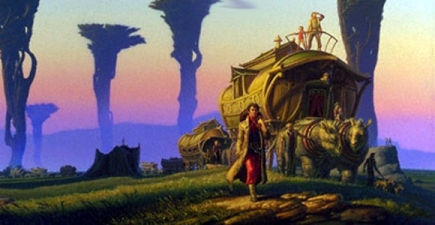

These nomads have encampments of thousands of gaily painted wagons, their herds of the reverenced bosk, often numbering into the millions, surrounding them.
Throughout the day, the camps are teeming with scarred warriors, kaiila, clad Kajir slaves, dour free women, haruspexes and domesticated sleen.
All Tuchuk men are expected to defend their encampment, so there are no castes as such, but clans, such as healers, leather workers and salt seekers exist, including the Clan of Torturers.
The Tuchuk warrior prays to the 'Spirit of the Sky' on kaiila-back with his weapons at hand, demanding victory and luck for themselves, defeat and misery for their enemies, primarily Turia.
'...chief of the things before which the proud Tuchuk stands ready to remove his helmet is the sky, the simple, vast beautiful sky, from which falls the rain that, in his myths, formed the earth, the bosks, and the Tuchuks.
Book 4: Nomads of Gor, pages 12, 21,27, and 28.
"The Tuchuks were commonly called the Wily Ones" Nomads of Gor, pg 75
"The Wagon Peoples grow no food, nor do they have manufacturing as we know it. They are herders, and it is said, Killers. They eat nothing that has touched the dirt. They live on the meat and milk of the bosk. They are among the proudest peoples on Gor, regarding the dwellers of the cities of Gor as vermin in holes, cowards who must fly behind walls, wretches who fear to live beneath the broad sky, who dare not dispute them the open, windswept plains of their world. The bosk is said to be the Mother of the Wagon Peoples, and they reverence it as such. The man who kills one foolishly is strangled in thongs or suffocated in the hide of the animal he slew."Page 5, Nomads of GOR
"The man facing me had several such scars ceremonially worked into the tissue of his countance, the highest being red, the next yellow, the next blue, the fourth black, then two yellow then two black again. The faces of the men were all scared differently, but each was scarred."Nomads of Gor, pg 16
"Without the Courage Scar one may not, among the Tuchuks, pay court to a free woman, own a wagon, or own more than five bosk and three kaiila. The Courage Scar thus has its social and economic, as well as its martial, import."Nomads of Gor, pg 113
"The man facing me had several such scars ceremonially worked into the tissue of his countance, the highest being red, the next yellow, the next blue, the fourth black, then two yellow then two black again. The faces of the men were all scared differently, but each was scarred." Nomads of Gor, pg 16
"The Tuchuks, not unlike Goreans in general, are fond of gambling. Indeed it is not unknown that a Tuchuk will bet his entire stock of Bosk on the outcome of a single kailla race; as many as a dozen slave girls may change hands on something as small as the direction that a bird will fly or the number of seeds in a tospit." From Nomads of Gor, p.60
"..from the distant, treeless plains of the south, though I did not know him; it was not by the epicanthic fold that I recognized him; it was by the courage scars, high on his angular cheekbones." Hunters of Gor,pgs 41-42
The Wagon Peoples, it is said, slay strangers. pg 9 Nomads of GOR
The mount of the Wagon Peoples, unknown in the northern hemisphere of Gor, is the terrifying but beautiful kaiila. pg 13 Nomads of GOR
Suddenly the Tuchuk bent to the soil and picked up a handful of dirt and grass, the land on which the bosk graze, the land which is the land of the Tuchuks, and this dirt and this grass he thrust in my hands and I held it. The warrior grinned and put his hands over mine so that our hands, together held the dirt and grass, and were together clasped upon it. 'Yes,' said the warrior, 'come in peace to the Land of the Wagon Peoples.' pg 26 Nomads of GOR
Among the Wagon Peoples, to be clad Kajir means, for a girl, to wear four articles, two red two black; a red cord, the Curla, is tied about the waist; the Chatka, or long , narrow strip of black leather, fits over the cord in front, passes under, and then again, from the inside, passes over the cord in back; the chatka is drawn tight; the Kalmack is then donned; it is a short sleeveless vest of black leather; lastly the koora, a strip of red cloth, matching the Curla, is wound about the head, to hold the hair back, for slave women, among the Wagon Peoples, are not permitted to braid, or otherwise dress their hair; it must be, save for the koora, worn loose. for a male slave or Kajirus, of the Wagon Peoples, and there are few, save for the work chains, to be clad Kajir means to wear the Kes, a short, sleeveless work tunic of black leather. pg 30 Nomads of GOR
He grinned a Tuchuck grin. 'How are the Bosk?' He asked.
'As well as may be expected,' said Kamchak.
'Are the Quivas sharp?'
'One tries to keep them so,' said Kamchak.
'It is important to keep the axles of the wagons greased,' observed Kutaituchik.
'Yes,' said Kamchak, 'I believe so.'
Kutaituchik suddenly reached out and he and Kamchak, laughing, clasped hands. pg 44 Nomads of GOR

